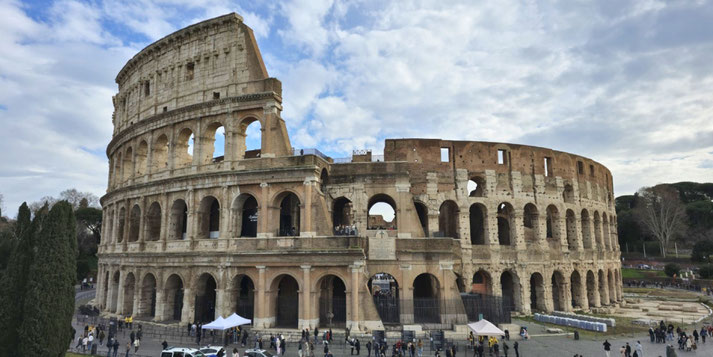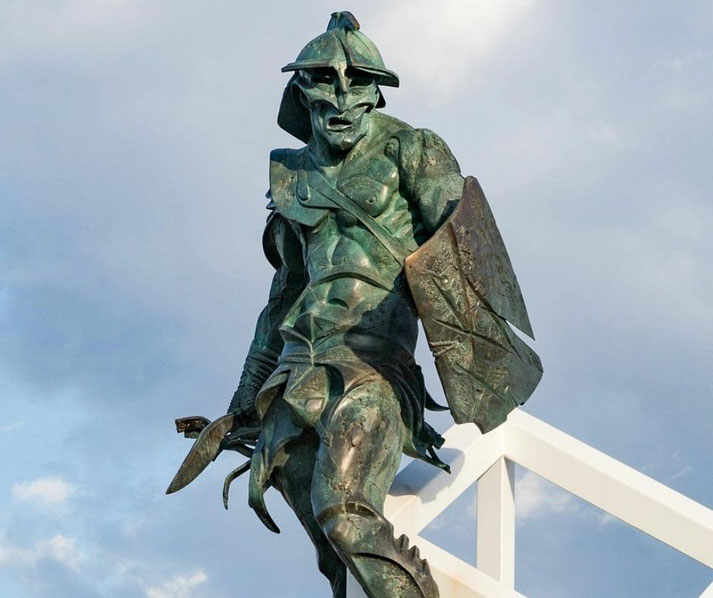The 7 most famous gladiators from ancient Rome

On the Colosseum's famous arena floor existed a world where gladiators, both feared and adored, fought for their very lives.
Even today, we know the names and achievements of the most well-known gladiators in all of Roman history.
Among them are a rebel military leader, a Roman emperor, and some of the most bloodthirsty killers of the ancient world.
The cut-throat competition of gladiatorial fights
The origins of gladiatorial games trace back to the early days of the Roman Republic, around the 3rd century BC.
They developed from Etruscan or Campanian funeral rites. In them, they appeared to offered blood to honour their dead.
However, as Rome expanded its territories, these games changed into a tool for political propaganda and public entertainment. By the 1st century BC, gladiatorial games had become a main feature of Roman culture.
Then, the inauguration of the Roman Colosseum in AD 80 under Emperor Titus, which could seat around 50,000 spectators, showed off a building that became the perfect example of the how to host violent entertainments.
In fact, a variety of events could be enjoyed there, including animal hunts, executions and, of course, gladiator battles.

The gladiators themselves were usually slaves, prisoners of war, or sentenced criminals, though volunteers also joined in search of fame and fortune.
In order to prepare, though, they trained in special schools known as ludi. The fighters were often categorised into different types based on their armour and fighting style such as the heavily armed 'Murmillo', the nimble 'Retiarius' or the adaptable 'Thracian'.
Even though the life of a gladiator was harsh and could be relatively short, those who did well could become popular heroes, or win substantial wealth and, in rare cases, their freedom.
Spartacus: The gladiator who led an armed revolt
Spartacus was born around 111 BC and was believed to be of Thracian origin. He was initially a soldier before he was captured and sold into slavery.
He was trained in the gladiatorial school of Lentulus Batiatus in Capua.
In 73 BC, along with about 70 fellow gladiators, he started a revolt that rapidly escalated into a widespread uprising against the Roman Republic.
The escaped gladiators armed themselves with kitchen implements and fought their way free, then raided the surrounding regions for proper weapons.
He soon gathered a growing army of dispossessed slaves and gladiators.
Under Spartacus’s leadership, this improvised army defeated several Roman legions sent to suppress them before roamed throughout Italy, swelling their ranks with even freed slaves.
Ultimately, Spartacus aimed to lead them out of Italy to freedom.
His army, at its height, had about 100,000 followers. However, the Roman Republic could not tolerate this challenge to its authority and dispatched Marcus Licinius Crassus to stop the rebellion.
In 71 BC, after a series of battles, Crassus managed to corner Spartacus and his army in southern Italy.
At the Battle of the Siler River Spartacus was finally killed and his army defeated.
Afterwards, slaves who survived were crucified along the Appian Way as a warning to anyone else who dared challenged Roman rule.

Flamma: The Syrian who refused freedom
Flamma was a gladiator from Syria, whose name meant ‘flame’, which was a good match his fierce reputation in the arena.
Little is known about his early life or how he became a gladiator. What we do know is that he took part in 34 contests, which was an impressive number.
Apparently, he won 21 of these contests, drew nine, and lost only four, a record that placed him among the very top gladiators.
What makes Flamma unique is that he was offered the rudis, the wooden sword that granted a gladiator their freedom, a total of four times.
Amazingly, he refused each time, and chose to stay a gladiator.
This decision puzzles historians. Was it the attraction of the arena, the status he earned, or a lack of options he had once he had his freedom?
Perhaps it was simply the praise of the crowd that gave his life purpose.

Crixus: The Gaul who fought alongside Spartacus
Originally a prisoner of war, Crixus was made a gladiator, but then fought alongside Spartacus in the Third Servile War in 73 BC.
He came from the same training school of Lentulus Batiatus in Capua as Spartacus.
Crixus became one of the rebellion’s key leaders and was reportedly an important factor in the early success of the movement.
However, Crixus and Spartacus started to clash over what to do with the success.
While Spartacus wanted to escape from Italy and send the rebel slaves back to their homelands, Crixus wanted to continue raiding and looting the Italian countryside.
His motives aren’t entirely clear, but historians speculate that he may have been driven by anger against Rome for his enslavement and suffering.
Regardless, Crixus and 30,000 of his followers split from Spartacus and marched off on their own.
Sadly, in 72 BC, Crixus and his group were fought the Roman legions under the consul Lucius Gellius Publicola and were defeated.
Crixus was killed, and his surviving men were crucified along the roads to Rome.

Commodus: The emperor who became a gladiator
Commodus, who was Roman Emperor from AD 180 to 192, was born to the philosopher emperor Marcus Aurelius, which meant that he grew up in the comfort and power of the ruling class.
Unlike his father, whose reign was guided by wisdom and stoic philosophy, Commodus showed an early interest in the gladiatorial games.
When he himself became emperor at the age of 18, he soon began to show behaviour that was considered to be unsuitable for the ruler of the empire.
He was known for his overindulgence and odd behaviour, but when Commodus entered the arena, such a spectacle had ever been seen from a Roman Emperor.
However, he thought his participation in the games was a way of showing strength imagined himself as the reincarnation of Hercules and appeared in the arena in the costume of that mythological hero.
Commodus fought against both professional gladiators and wild animals, although these fights were often rigged to guarantee his victory.
As a result, the emperor’s gladiator efforts met a mix of fascination and horror among the people.
Some admired his physical skill and bravery, but many saw it as a dishonouring display that lowered the status of the imperial office.
Ultimately, he was assassinated in 192 AD.

Priscus and Verus: duel that ended in mutual respect
The next gladiators come from an account of their fights that comes from the 1st century Roman poet Martial, who wrote about it in his book of spectacles.
According to Martial, two warriors, called Priscus and Verus fought in the Flavian Amphitheatre, now called the Colosseum, during the opening games held by Emperor Titus in 80 AD.
These celebrations lasted one hundred days, during which the duel between Priscus and Verus stood out as one of the longest and hardest battle that the crowd had ever seen.
They fought with such determination that Martial reports the match was eventually stopped and both were given the rudis: the wooden sword that marked a gladiator’s freedom.
This outcome was very rare; it almost never happened that both fighters in a match earned freedom at the same time.
Fights usually ended in death or with a clear winner. In contrast, the duel of Priscus and Verus went against the usual result because it was so evenly matched.

Tetraites: Master of the hoplomachus style
Our next person was a hoplomachus, a kind of gladiator that used a spear, a small round shield, and a dagger.
They were based on Greek hoplites, and they relied on distance and quick footwork to control the fight.
Most of what we know about the hoplomachus named Tetraites comes from objects and art that have survived from the period.
Images of him appear in mosaics, including one discovered in Risan, Montenegro, where Tetraites appears in the middle of battle. He holds a spear in traditional hoplomachus style.
However, he is best known for his victory over the champion gladiator Prudes, who was on a winning streak of 20 consecutive fights before being defeated by Tetraites.
This victory instantly propelled Tetraites to legendary status across the Roman Empire.
His name and image appear on graffiti in Pompeii and glass vessels found in regions as distant as France, England, and Hungary.
Apart from that, we know nothing else of his life. There is no definitive historical record detailing the ultimate fate of Tetraites, whether he lived the rest of his life enjoying his fame, or whether he eventually died on the floor of the arena as well.
What do you need help with?
Download ready-to-use digital learning resources
Copyright © History Skills 2014-2025.
Contact via email
With the exception of links to external sites, some historical sources and extracts from specific publications, all content on this website is copyrighted by History Skills. This content may not be copied, republished or redistributed without written permission from the website creator. Please use the Contact page to obtain relevant permission.





